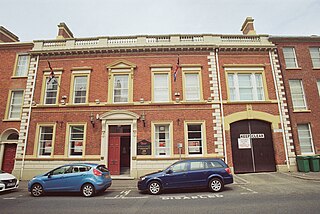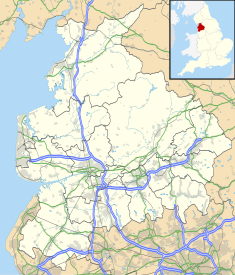
Okehampton Town Hall is a municipal building in Fore Street, Okehampton, Devon, England. The town hall, which is the meeting place of Okehampton Town Council, is a Grade II* listed building.

South Cave Town Hall is a municipal building in the Market Place, South Cave, East Riding of Yorkshire, England. The building, which is the meeting place of South Cave Parish Council, is a Grade II listed building.

Hedon Town Hall is a municipal building in St Augustine's Gate, Hedon, East Riding of Yorkshire, England. The building, which is the meeting place of Hedon Town Council, is a Grade II* listed building.

Witham Town Hall is a municipal building in Newland Street, Witham, Essex, England. The building, which is the meeting place of Witham Town Council, is a Grade II listed building.

Thornbury Town Hall, is a municipal building in the High Street, Thornbury, Gloucestershire, England. The building, which is the meeting place of Thornbury Town Council, is a Grade II listed building.

Wallingford Town Hall is a municipal building in the Market Place in Wallingford, Oxfordshire, England. The building, which is the meeting place of Wallingford Town Council, is a Grade I listed building.

Woodstock Town Hall is a municipal building in the Market Place in Woodstock, Oxfordshire, England. The building, which is used as a community events venue, is a Grade II listed building.

Langport Town Hall is a municipal building in Bow Street in Langport, Somerset, England. The building, which is the meeting place of Langport Town Council, is a Grade II listed building.

The Town House is a municipal building in Union Street in Yeovil, Somerset, England. The building, which is the meeting place of Yeovil Town Council, is a Grade II listed building.

Axbridge Town Hall is a municipal building in The Square in Axbridge, Somerset, England. The building, which is the meeting place of Axbridge Town Council, is a Grade II listed building.

The Old Town Hall is a municipal building in the Market Place in Wilton, Wiltshire, England. The structure, which is currently used as a Baptist church, is a Grade II listed building.

Bewdley Guildhall is a municipal building in Load Street in Bewdley, Worcestershire, England. The structure, which is the meeting place of Bewdley Town Council, is a Grade II* listed building.

Bala Town Hall, known in the late 19th century as the County Hall, is a municipal building in Bala, Gwynedd, Wales. The structure, which is now used as a restaurant, is a Grade II listed building.

The Old Town Hall is a municipal building in Old Market Street, Usk, Monmouthshire, Wales. The structure, which is now used as the local club of the Royal British Legion, is a Grade II listed building.

Fishguard Town Hall is a municipal building in the Market Square, Fishguard, Pembrokeshire, Wales. The structure, which is the meeting place of Fishguard and Goodwick Town Council, is a Grade II listed building.

Crickhowell Market Hall, formerly Crickhowell Town Hall, is a municipal building in the High Street, Crickhowell, Powys, Wales. The structure, which accommodates market stalls on the ground floor and a café on the first floor, is a Grade II* listed building.

The Old Town Hall is a municipal structure in Castle Street, Lisburn, County Antrim, Northern Ireland. The structure, which is used as a constituency office by the Democratic Unionist Party, is a Grade B2 listed building.

The Corn Exchange is a commercial building in Nottingham Street in Melton Mowbray, Leicestershire, England. The structure, which is now used to provide access to a shopping centre, is a Grade II listed building.

Lostwithiel Guildhall is a municipal building in Fore Street in Lostwithiel, Cornwall, England. The structure, which currently accommodates the local museum, is a Grade II listed building.

The Old Town Hall is a municipal building in St Mary Street, Newport, Shropshire, England. The structure, which is now divided into a series of shop units on the ground floor and used as a children's play area on the first floor, is a Grade II listed building.


























